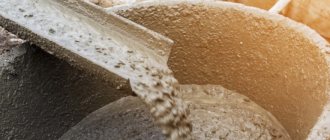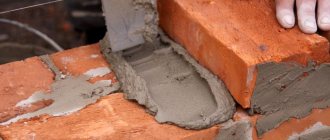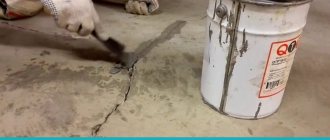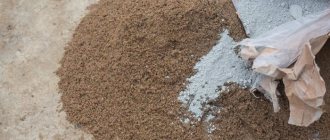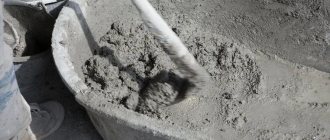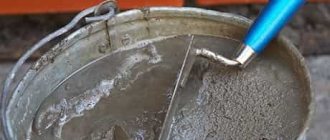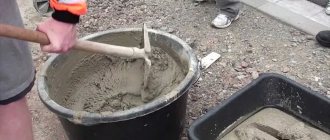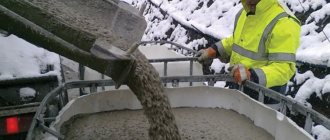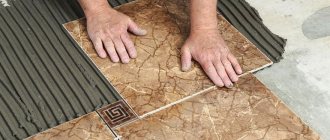When performing construction and repair work, concrete is used in significant quantities. It’s a shame when, after a long, costly and labor-intensive concreting process, after a short time the concrete mass becomes covered with a network of cracks and gradually splits. To prevent this from happening, it is necessary to increase the elasticity of the cement mortar. Various additives are used for this.
By making a plasticizer for the solution yourself, you can significantly reduce construction costs and prevent cracking of concrete after hardening. So, let's consider in detail what a plasticizer is, what it is used for and how you can make it on your own.
Experts call a plasticizer a polymer-based material that serves as a means of increasing the plasticity of building mortars.
What is it - a plasticizer for cement mortar
A plasticizer for cement is a special composition that modifies the concrete mixture and improves its performance characteristics. The introduction of a certain additive can, for example, simultaneously increase plasticity, increase frost resistance and have a positive effect on the process of cement hydration. Thanks to the introduction of special additives, the moisture concentration is reduced, which facilitates the laying of blocks and improves the quality of the concrete monolith.
A cement plasticizer introduced into a concrete mixture performs a number of serious tasks:
- increases the mobility of concrete;
- prevents stratification of the solution;
- reduces the volume of added water;
- improves strength characteristics;
- provides enhanced contact with steel reinforcement;
- makes it difficult to saturate the massif with destructive moisture;
- prevents cracking;
- promotes concrete resistance to temperature changes;
- increases the storage time of prepared cement mortar;
- makes it easier to fill molds with the composition and perform masonry;
- reduces shrinkage during hydration.
Many beginners, trying to save money, resort to making the material themselves, using their own “individual” recipe.
When making a plasticizer for a solution with your own hands, it is important to ensure the following characteristics of the additive:
- No toxicity. The supplement should not adversely affect the human body.
- Chemical resistance. The composition should not react with other ingredients of the cement mixture.
- Maintaining consistency. The additive should not evaporate when the concrete hardens.
- Application temperature. The additive must comply with the conditions for its introduction into the concrete composition.
Compliance with the requirements will ensure the required quality characteristics of the cement mortar.
Expert opinion: Plasticizer for cement mortar
A plasticizer added to concrete improves the strength and elasticity of the concrete mixture. A homemade plasticizer for cement will of course save money during construction, but it is best to use industrial plasticizers. This way you will protect yourself from a number of problems that may arise during the hardening of concrete with a self-made plasticizer, which can ruin all further construction work.
Additives for mixtures - to accelerate hardening and enrich with oxygen
The considered method of preparing the mixture allows you not only to save a decent amount of money, but also to improve the quality of concrete. However, in many cases, builders simply cannot do without special additives. It is quite difficult to prepare them yourself, and for this you will have to spend a lot of time looking for ingredients.
Mixing a solution with a plasticizer
The first category of additives includes substances that accelerate the hardening of concrete. They become simply irreplaceable in cases where the work must be not only high-quality, but also fast. For example, such additives are used when forming a pool bowl using combined formwork. In such cases, to fill the walls, you need to wait until the bottom of the structure has completely hardened. When using the supplement, this will happen several times faster. Hardening accelerators are also indispensable during construction in late autumn. Low temperature slows down the hardening of the mixture and the development of strength, and the accelerator will help compensate for lost time.
Additives that slow down the hardening of concrete are used in situations where a conventional plasticizer is no longer enough. Thus, they are used when transporting mixtures over long distances, or when you need to leave the cement for a while and do other work. Typically, using such additives gives workers a few extra hours so they can solve problems without worrying about wasted mixture. Compounds similar to retardants include water reducers that have the same properties.
To prepare a solution, special substances are often added to the plasticizer to help create air bubbles in the mixture. These additives are mixed directly into the concrete mixer. After thorough mixing, builders receive a finished material that can withstand the effects of frost for a long time. Water that gradually permeates a building under the influence of frost can expand, entering air pores. This option is considered one of the cheapest for achieving reliability of a concrete structure. However, this method has one big disadvantage: it will not be possible to make high-strength concrete with such bubbles. In such cases, you will have to reduce the amount of water, or add ash to the mixture.
Plasticizer for cement - manufacturing rules
A plasticizer for cement is introduced in compliance with the required proportions:
- Liquid soap or shampoo with a volume of 0.2 liters is added to 50 kilograms of Portland cement when preparing concrete. The introduction of an additive at the initial mixing stage allows you to increase the hardening time of concrete by up to 3 hours. This is convenient for the production and pouring of increased volumes of concrete mixture.
- Slaked lime is mixed with the concrete mixture in an amount of no more than 20% of the weight of cement for finishing building facades and in a 1:1 ratio for interior work. The additive increases the elasticity of concrete and gives it adhesiveness, which makes it possible to carry out complex work, ensure uniform application and smooth masonry joints. An additional advantage is the high bactericidal properties of the resulting cement mortar.
- Washing powder is pre-diluted with water and added when mixing the composition at the rate of 0.1–0.15 kg per bag of cement. The powder-based additive slows down the hydration process, increasing the hardening threshold.
- Polyvinyl acetate adhesive (PVA) is mixed with pre-prepared concrete. For each bucket of concrete, 0.2 liters of glue is added, which increases the resistance of the cement mortar to moisture penetration.
The use of chicken egg white as a modifier has ancient roots. The introduced protein significantly increased the lifespan of buildings, many of which survived centuries. The recipe was passed down from generation to generation, but in our time it has lost its relevance when, thanks to the development of the chemical industry, many modern compounds produced industrially have appeared.
So, to make cement mixtures more plastic, you will need to use hair shampoo, liquid soap, liquid washing powder and lime
Video - influence of plasticizer on suspension
The use of plasticizers during independent construction allows you to avoid problems with laying concrete and increases the elasticity and quality of the concrete composition. The addition of plasticizers must be done in proportions suitable for the base material.
When making a plasticizer, you must adhere to certain rules, compliance with which will lead to a high-quality result. The additive must have the following characteristics:
- not be toxic;
- do not have a “volatile” consistency;
- be chemically stable;
- have a decomposition temperature lower than the processing temperature.
Masonry mortar is a composition of aggregate and binder, where the latter may be lime or cement. The filler will be sand without impurities and debris.
Depending on the type of binder, there are:
Cement
Made from sand and cement. The main disadvantage of the resulting solution is low plasticity, but good strength. To make the solution better, experienced masons add washing powder. But this must be done according to the rules, and not by eye.
If you compare the powder with cocoa, then when you add water, lumps will appear. The same processes occur with cement due to its poor wettability. Therefore, you should first mix sand with cement, and then carefully add water to the composition.
Lime
Rarely used due to low strength. But this solution is taken to improve the quality of compositions with Portland cement.
Technological features
Wanting to save financial resources and using a self-made plasticizer, builders are faced with problematic situations:
- the appearance of salt stains on hardening concrete. This is due to the leaching of salt onto the surface of the concrete mass when soap is introduced;
- difficult to predict concrete hardening time. The ingredients in soap have different effects on the hardening of cement;
- absence of pores inside the concrete monolith. A soap-based additive complicates the migration of water in concrete, disrupts the structure of the mass, which quickly absorbs moisture, which contributes to the formation of mold;
- increased shrinkage of cement mortar. The detergent does not form microscopic pores inside the monolith, which increases the density of concrete and increases the load on the foundation;
- lack of the desired effect from the introduction of a modifying additive. The introduction of soap, which is an alkaline medium, into the finished concrete reduces the effect. It is necessary to add soap at the initial stage of kneading;
- increased foaming. When intensively mixing the solution in a concrete mixer using detergents, intensive foam formation is possible. You should pause mixing, wait until the foam settles and continue the process.
Popular Supplement Brands
Plasticizers reduce water demand without changing the consistency of the mixture, while superplasticizers can significantly reduce the water content.
This category includes one of the popular brands of plasticizer for concrete, C3. The additive is produced using the method of organic synthesis of cellulose compounds. The result is surfactants that increase the strength of the concrete solution.
plasticizer for concrete C3
The Sika brand concrete plasticizer is a low-cost material intended for the production of concrete and reinforced concrete products and other structures. The additive in this series is highly compatible with aggregates and various types of cement. Capable of reducing water requirements by up to 40%, resulting in a strong and durable concrete matrix.
One of the popular additives for accelerating the strength gain of concrete, increasing its frost resistance and water resistance is the TechnoNIKOL plasticizer. It is produced in liquid form and is used for all types of foundations, blind areas, door and window slopes, and is used when installing heated floors.
plasticizer TechnoNIKOL
Why are they added?
The main advantages of introducing surfactant additives into concrete include:
- Increased fluidity and mobility of the solution, resulting in increased ease of placement, it fills the formwork better. The likelihood of voids forming, especially when filling frames of complex structures where vibration compaction is difficult, is reduced.
- Reducing the amount of water in the solution: it gains strength faster.
- Better grip on the surface (adhesion).
- Resistant to cracking and temperature changes. Frost resistance.
- Strengthening the water-repellent properties of plaster.
- Ensures uniform mixing and reduces the risk of water separation and segregation.
- Increasing the strength and service life of concrete.
According to the methods of action, all plasticizers can be divided into:
- Hydrophilic action. By increasing wettability, the formation time of colloids (particles mixed in a medium with another substance) is reduced, resulting in increased fluidity and plasticity.
- Hydrophobic. Enriched with air bubbles. Increase the plasticity of the mixture and the strength of the plaster.
According to the degree of effectiveness, plasticizers are divided into:
- Superplasticizers. Manufactured from melamine polymers.
- Hyperplasticizers. The composition contains polycarboxylates. More active than superplasticizers. Due to their high cost, they are mainly used to create thin-layer self-leveling mortars, for example, for self-leveling floors.
Purposes of introducing plasticizers
To obtain a durable monolith, it is necessary to ensure uniform distribution of the cement mortar between the filler particles. The simplest way to achieve this is to increase the mass fraction of water.
On the one hand, this allows you to increase the fluidity of the mixture, on the other hand, excess moisture worsens the technical characteristics of concrete after hardening.
The optimal solution to this problem would be the use of plasticizers, the introduction of which into the mixture allows solving several problems:
with a decrease in the amount of water and cement, the strength increases by 15–20% ;
the risk of cracking is reduced;
the plasticity and fluidity of the concrete mixture increases;
there is a significant reduction in the reduction in concrete shrinkage during hardening;
frost and moisture resistance increases;
the adhesion of the mixture to the reinforcement improves;
the lifetime of the finished solution increases.
Plasticizers for cement mortars on sale
Plasticizers can be made from mineral, organic or inorganic substances. The most common commercially available formulations include:
ArmMix Superplast (Russia) . Belongs to the class of superplasticizers. Water-based from organic and inorganic salts for interior and exterior use. Can be used for masonry, foundation mortars, foam and fiber-reinforced concrete, production of mixtures for floor screed, paving and facade slabs. Suitable for mortars and concrete of any grade. Consumption: 0.2% by weight of cement.
Saponified wood resin . Superplasticizer. A composition with a water-repellent effect obtained as a result of the hydrolysis of esters of deciduous and coniferous wood. It is a foaming agent and forms a large number of air bubbles, reducing density. Used in the production of lightweight concrete, expanded clay concrete, foam concrete, etc. Increases mobility, frost resistance and thermal insulation properties. Concrete based on it allows less moisture to pass through. Consumption 0.1-0.3%.
Superplasticizer S-3 . One of the frequently used inexpensive plasticizers. The composition contains naphthalene-formaldehyde sulfate. Improves the service life of concrete structures, including cement plasters. When introduced into a sand-cement mortar, it reduces its delamination, increases fluidity and mobility. Low consumption. 100 kg of cement requires 5-7 kg
Mplus . Liquid mixture based on a complex of salts. It increases not only plasticity, but also density, resistance to physical stress, uniformity of concrete and slows down its setting. Reduces cement consumption. Used in mortars for pouring and screeding floors. Consumption 1 liter per 100 kg of dry cement.
Mapei Planicrete . The main component is synthetic rubber. Increases plasticity, mobility, ability to retain moisture, adhesion to the surface of the solution and its strength. For external and internal works. Consumption may vary depending on the purpose of the cement-sand mixture and is 200-300 kg/sq. m.
Using additives for heated floors
A plasticizer for underfloor heating screed is a mandatory component. It must be added to the composition to obtain certain properties and characteristics.
- The strength of the poured coating is significantly enhanced.
- Thermal expansion is reduced.
- Thermal conductivity and resistance to temperature fluctuations increase.
- The level of susceptibility to corrosion of heating system elements is reduced.
- The number of air bubbles is significantly reduced.
There is a separate line of additives designed specifically for heated floor screed
. In fact, many who install a floor heating system ignore this recommendation, especially when independently preparing the mixture for pouring the screed. This situation leads to negative consequences:
- The mortar used, especially cement-based, undergoes constant expansion due to temperature fluctuations, which leads to the appearance of deformations and numerous cracks.
- Air bubbles present in the composition contribute to a significant increase in the temperature inside the floor covering, this disrupts the operation of the entire thermal system.
- High thermal conductivity is not inherent in the standard mixture; it is the presence of plasticizers that increases this parameter and increases the overall efficiency.
Thus, when choosing ready-made materials for pouring screed onto a heated floor, it is advisable to check in advance whether they contain the necessary additives.
How to make your own supplements?
If you want to save money, then instead of factory additives for plasticity, you can add plasticizers prepared by yourself to the cement mortar:
- Slaked lime: in addition to increasing elasticity, it has bactericidal properties and protects against the appearance of fungus, increases adhesion and crack resistance. When finishing brick houses built back in Soviet times, fluff lime was used.
- Liquid soap or washing powder dissolved in water. Extend setting time.
- PVA glue: also increases the water resistance and strength of concrete mixtures.
Most often, at home, slaked lime (fluff) is added to the cement mortar for plasticity. It is added to the dry mixture in a proportion of no more than 20% by weight of cement. It becomes much easier to work with cement-sand mortar; it becomes more mobile and easily distributed over the surface.
If lime is introduced in the form of a dough, it is first diluted to the state of lime milk. Sand and cement are mixed dry, and then milk is added to them to the desired consistency.
When using fluff lime, all components are mixed dry and then filled with water.
Another way: thick lime paste is mixed first with 1/2 of the sand, cement with the second part. Then both mixtures are combined and water is added to it.
Important! Only slaked lime is used in solutions. You need to prepare it in advance, at least a day in advance. Otherwise, it will react with water and reduce the strength of concrete.
Using detergents as plasticizers
Unlike lime, detergents are introduced into the cement-sand mortar in a smaller proportion. Add 200 ml of liquid soap or detergent to a standard 50 kg bag of cement. The same amount of washing powder requires only 100-150 g. If it begins to foam when mixed with water, you should wait until the foam settles.
What can be replaced
In Moscow and other big cities, it is easy to purchase any supplement inexpensively. When working in remote areas and there are no additives on sale, there is a way out.
The following substances can be added to masonry mortar or concrete as modifiers:
- To give the solution water-repellent properties, increase its strength and mobility, you need to add PVA glue to the composition. You will need 200-250 g of glue per 10 liters of mixture.
- Another option to choose a replacement for the factory plasticizer for cement mortar with your own hands is to add slaked lime. It should be mixed into concrete no more than 20%. In this case, the likelihood of cracks will decrease and ductility will increase. Products, for example, paving slabs, will become resistant to sudden changes in temperature, their surface will be smooth, even, and durable. If lime is used as an additive, then other substances cannot be used together with it.
- You can pour a little dishwashing detergent into the solution. For 12 kg of cement (bucket) you will need 2 tbsp. l. household chemicals. The foam resulting from stirring, enveloping the particles of the binder and filler in the solution, will make it elastic.
- Washing powder can increase the mobility of building mixtures. At the same time, greater foaming is achieved by the composition for hand washing - less expensive. 2 tbsp. l. There will be enough cement for a bucket.
- To save money, liquid soap is suitable. It is sold in 5 liter bottles. It is better to take not the cheapest product. Proportions - 2 tbsp. l. onto a bucket of cement. Similarly, pour in solid laundry soap crushed on a vegetable grater.
Types of cement-sand plaster
Despite the abundance of modern offers of dry mixes, cement-based compositions remain the most popular to this day. A layer of cement plaster performs aesthetic and sanitary functions, it is used to level surfaces, it protects walls from various types of damage, it is an excellent thermal insulator and absorbs noise well.
Based on their composition, solutions are divided into:
Watch how slopes are plastered with cement mortar; video tips will help you do the work yourself.
Cement-sand mortars
Cement-sand compositions are used for external and internal work, they are very durable, not afraid of moisture, temperature changes, durable, the only drawback is that the solution takes a long time to set and dry. The main element of the composition is cement - this is a binder, the brand of which determines the area of application of the plaster:
- M150-300 – interior decoration;
- M300 and more – facade work, open balconies, rooms with a difficult microclimate, for example, bathrooms.
Sand is the second important ingredient of the cement mixture, the quality of which determines the reliability and strength of the solution. It is recommended to use sand of medium fraction; small sand grains in the composition can lead to cracking of the plaster layer after drying; they are added to apply the last thin layer to obtain a smooth surface. Coarse sand is used only in facade finishing.
In industrial conditions, other components can be added to the finished cement-sand mortar to improve the characteristics of the composition. Additives such as redispersible polymers and copolymers increase the plasticity and strength of the solution, improve adhesive and hybrophobic properties, and frost resistance.
For a layer of cement plaster more than 50 mm, a reinforcing mesh will be required
Features of the cement-lime composition
Cement-lime plaster, according to regulations, is used only in rooms with a relative humidity of less than 65%. In addition to cement and sand, its composition includes slaked lime, which lightens the weight of the solution, gives it additional elasticity, it sets faster, and it is much easier to work with the mixture.
To prepare cement mortar with your own hands, the lime must be quenched and left for about 2 weeks. If you neglect these instructions, the quality of the plaster will significantly decrease; bubbles will appear during the work, which will lead to a violation of the integrity of the plaster layer. High-quality cement mortar with lime paste is vapor-permeable and durable.
Ready-made mixtures from manufacturers include the following components:
- Portland cement;
- slaked lime (hydrate);
- quartz sand;
- water retaining additives;
- polypropylene fiber.
Important: Some cement-lime mortars can be used for external plastering; usually the manufacturer indicates this specificity on the packaging.
When working with a dry composition, you must strictly adhere to the instructions, such as when there is excess water. The composition loses its strength characteristics and performance deteriorates.
Tools for cement plaster
Gypsum or cement plaster, which is better?
It is impossible to unequivocally answer which plaster is better, gypsum or cement; each type of mortar is applicable in its own conditions, and often both compositions are used in repairs. In addition, they share common characteristics:
- the mixed solution retains its qualities for up to 6 hours;
- frost-resistant;
- solutions can be applied at a temperature delta from +5 to 30 o C;
- You can putty and paint plastered surfaces after 2 weeks;
- after 3 days the layer of plaster can withstand the gluing of tiles;
- It is recommended to store the dry mixture for no more than 1 year, in a tightly closed container, in a dry place.
To decide which is better suited, gypsum or cement plaster, you should evaluate the area of work, the operating conditions of the surfaces, and the purposes for which the surface is being leveled. Thus, it is believed that it is better to choose a gypsum composition for wallpapering and painting, and a cement composition for tiling in rooms with high humidity.
The solution should be thick and stick to the trowel
What properties does a plasticizer give to plaster?
Adding a plasticizer makes the plaster more plastic, flexible, mobile and viscous, and also allows it to not set for longer, which means you can work at a calm pace or dilute more mortar at once. Plaster with plasticizer “lives” three times longer than a solution without this useful additive, that is, you can mix a solution and it will last for a whole day of work.
Important!
Cement mortars shrink during the hardening process, and as a result, cracks and detachments of the plaster from the surface may appear. To prevent this defect, a special reinforcing mesh is used, located between two layers of plaster. Naturally, the use of mesh complicates the coating process and significantly slows it down.
A replacement for the mesh is polypropylene fiber, which is added directly to the solution. Its advantages:
- light weight;
- ease of distribution in solution;
- harmless to the skin of the hands.
Plaster mortar with polypropylene fiber fiber is durable, shrinks less and does not develop cracks.
How to prepare cement mortar for plastering walls
The main components of cement plaster are a binder (cement) and filler (sand); additionally, the composition may include lime, clay, and polymer additives. The proportions of cement and sand for plastering walls depend on the chosen brand of binder and the area of application of the solution. We obtain the finished plaster from a dry mixture, filling it with water, the amount of which largely affects the saturation of the solution, and therefore the quality of the finish. Types of solutions:
- greasy - a large percentage of binder, the plaster often cracks during its formation;
- skinny - a lot of water and filler, the plaster layer is weak and can peel off;
- normal - the ratio of sand and cement for plaster is maintained in accordance with the brand of binder and sandstone fraction.
Application and purpose of plasticizers
Plasticizers for concrete are used at different stages of construction, so let’s figure out why they are needed and what types they are. Such additives make it possible to increase the strength of mixtures by 30%, reduce its consumption by 5%, and water consumption by a quarter.
Other positive qualities include the following:
- increasing the time of use of the finished solution;
- improving the quality of the material;
- increase in adhesive properties;
- ease of laying the mixture;
- frost resistance.
Consumption of cement plaster
Calculate the thickness of the plaster layer:
- we clean the surface of the old finish, remove the weak layer, and, if necessary, knock down strong irregularities;
- we identify the most convex place, hang the wall, put stamps on the ceiling;
- in 3-5 places, place a ruler perpendicular to the surface, measure deviations from the plane, add up, calculate the average;
Wall 8 m2, deviation measurements: (3+6+1+4+1): 5=3 cm middle layer of plaster. If you plan to plaster on finished beacons, it is important to take into account the thickness of the guides, from 3-10 mm, depending on the model, we will take 3 mm, we get a plaster layer: 3 + 0.3 = 3.3 cm.
Different types of cement and gypsum mixtures have different consumption per 1 m2, usually the data is indicated on the packaging. So, the average is 8.5 kg of dry composition per 1 m2, layer 10 mm.
Calculations: 8.5 * 3.3 (thickness of our layer) = 28 kg of mixture will be required in our case per 1 m2, which means to plaster our 8 m2 wall: 28 * 8 = 224 kg. An average bag contains 30 kg - 224:30 = 7.5 m. This is quite a large amount and will require significant financial investments. Homemade cement plaster will cost 2-3 times less, its standard consumption is regulated by SNiP, and is indicated in tables for different surfaces and application methods. For example, for a porous base made of foam concrete, aerated concrete, the consumption will be greater than for plastering monolithic concrete structures.
Table of cement mixture consumption for plastering surfaces of various types, per 100 m2
Leading manufacturers
When serious construction is ahead, it is better not to rely on homemade additives, but to choose ready-made ones. There is no big difference between manufacturers. If there is a company you trust, take their supplements. If you are at a loss, then here are some reliable companies producing plasticizers:
- Barwa Sam . The Polish company was founded in 1960. Initially, they produced paints and plasters, and have now included plasticizers in their product range, as well as additives that accelerate and retard setting, and fibers for micro-reinforcement. In 2006 we received ISO 9001:2001 certificate.
- Mapei . This Italian brand produces self-leveling mixtures, latex and other additives, grouts, impregnations and much more.
- Monomakh . A domestic brand that uses imported components to produce a combined plasticizer in two series.
- ArmMix . Also, a Russian company that has a line of environmentally friendly Russian manufacturer produces a whole series of environmentally friendly additives (plasticizers for concrete, hardening accelerators, antifreeze additives).
- Hermes . Ukrainian company that makes plasticizers through organic synthesis.
When purchasing supplements, be sure to ask your consultant for a certificate of conformity to avoid counterfeits.
Plastering walls with cement mortar with your own hands - video and detailed instructions
Before starting work, surfaces should be primed to increase the adhesion characteristics of the finish. Plastering walls can be done mechanically or manually and includes several stages:
- Spray, layer thickness: on concrete - 5 mm, brick - 7 mm, wood - 1 mm. We wet the wall. We take a solution of medium consistency into a ladle or spray bottle, pour it onto the surface, level it with a rule or a trowel. If a layer of more than 50 mm is further required, we attach a reinforcing mesh.
Plastering walls with cement mortar with your own hands, the video shows detailed tips on how to spray.
- The soil is a thick solution, we scoop it up with a plaster falcon and apply it to the surface with a trowel. We wait 30 minutes, level it with a long rule, add solution to the holes, remove the bulging areas and straighten again.
- The covering is done with a liquid plaster mixture, layer thickness up to 4 mm. We moisten the previous layer, add the solution and carefully smooth it in a circular motion.
The materials in the video below will tell you the secrets of how to plaster walls with cement mortar, and the video instructions will help you figure out how to use the tool.
Plastering walls with cement mortar on beacons
We hang the walls, set up beacons: metal, plastic, wire, mortar or drywall. The distance between the guides is 150-300 mm less than the length of the rule. To increase the adhesion of the plaster to the surface, apply a primer.
Advice: It is better to cover an area of 2 m2 at a time; on average, such an area requires a bucket of solution.
Using a trowel, apply the solution from bottom to top, a little more than the required layer, there should be no gaps. As a rule, we carefully move it up and swing it slightly from side to side, and for the second pass we move the tool evenly. We apply a level; there should be no gaps between it and the surface. If necessary, add cement mortar again and repeat the procedure.
For details, watch the video on how to plaster walls with cement mortar using beacons; the video tutorial will help you understand all the nuances of the work.
Advantages of using a plasticizer for concrete
The use of plasticizing additives has many positive aspects, among which are:
- High quality and optimal price. With the use of a plasticizer, cement consumption is reduced by approximately 25%, which makes it possible to reduce costs.
- Increasing the life time of the mixture by 4-5 hours if long-term transportation is necessary. In this way, you can save time that could have been spent constantly stirring the finished solution.
- Increase in composition strength by approximately 20%. In practice, it has been proven that work with the base can be started earlier; there is no need to wait 28 days for the concrete to cure.
- Increased drying time. This advantage will make it possible to pour the foundation in several stages without knocking down the top layer of concrete. This will only increase the strength and prevent cracks from appearing on the surface.
- Possibility to use special equipment. When constructing objects, low-elasticity mortar must be lifted to the floors manually. With the use of a plasticizer, its elasticity increases, which makes it possible to attract the gas pump to work.
- When laying the mixture, there is no need to use a vibration compactor. This tool is designed to mix the solution and remove excess air bubbles. Due to the fact that the concrete mixture becomes mobile, there is no need to use a vibrating compactor.
- Maximum filling of voids. Thick concrete does not easily fall through a large amount of reinforcement; with the addition of a plasticizing agent, this problem will disappear. Thanks to this, the base becomes more durable and will not crack under heavy load.
- Increased waterproofing. The solution becomes thicker, and at sub-zero temperatures the risk of concrete rupture is reduced.
Appearance
Plasticizer C-3 is a dark brown liquid or light brown powder.
The powder is sold in 25 kg bags, and the liquid is sold in 0.5 liter plastic bottles. Which one to buy depends on how long it will be used. If it is necessary to store a substance for a long time, then preference should be given to a powdered plasticizer - it can be stored for a long time, but only on condition that moisture does not get into it. Liquid plasticizer S-3 is more suitable for the construction of small structures, when you need to prepare a small amount of solution for work.
What is useful for mixing - liquid soap or lime?
Craftsmen know well that to prepare elastic plasticizers, you need to add a small amount of liquid soap to the mixture. This method was used by the old-timers, and we can see the results of their work today. Often slaked lime, shampoo or liquid washing powder were added to the mixture. In those days, builders came up with mixture recipes based only on personal experience and mistakes.
PVA glue is a good plasticizer
For the first time, the role of the mixture to impart plasticity to the solution was played by ordinary protein from a chicken egg. This method still allows you to save significant amounts of money. Unlike preparation at home, factories for the production of mixtures use foam concrete, expanded clay block, heat block or cinder block. These components improve the quality of cement several times and make it much more stable. Working with these components is not easy, especially for a person who has no experience in such work. Therefore, it is worth considering the old-fashioned method in more detail. Moreover, the quality of the mixture will not be significantly inferior to the factory one.
So, to make cement mixtures more plastic, you will need to use hair shampoo, liquid soap, liquid washing powder and lime. Don’t forget about egg whites, which must be present in the mixture. To make a plasticizer for concrete with your own hands, you should not look for any clear proportions - they simply do not exist. However, there are a lot of useful recommendations from more experienced builders that are worth listening to.
First of all, you need to pour a bag of cement into a container and add 250 ml to it. liquid soap and 100 ml. liquid washing powder. This will slow down the drying of the mixture, and you will be able to work with it for at least three hours. In addition, when using liquid soap, cracks or chips will not appear on the finished concrete. Do not experiment and add soap at the end of kneading. Otherwise, it will settle as a layer on top of the expanded clay and lose its basic properties. If you will use the finished mixture in the future for the construction of structures that do not require high reliability, then you can use less cement.
If expanded clay blocks in granules are used to build walls, then liquid soap and washing powder will become mandatory components. They will envelop each of the granules, significantly improving the adhesion of the material to the cement. In this case, you do not need to pour a large amount of water into the mixture, otherwise you will then have to add more cement. To make the substance more sticky, use slaked lime and shampoo. They will make the masonry more uniform and smooth. However, when using these components, you should not prepare the mixture in a concrete mixer. In this case, the material will foam, and you will have to wait until the foam settles.
And, of course, don’t forget about proteins. For 1 bag of cement, 3 separated proteins are enough, which will make it easier to work with the mixture and make the concrete more durable.
Industrial compounds versus handmade
Modern building mixtures have remarkable characteristics that are many times superior to those of their predecessors a few decades ago.
In Soviet times, tile adhesive was diluted on cement, experimenting with the ingredients, identifying the ideal composition by trial and error, and today in construction stores, eyes run wide from the options for tile adhesive. And this is just one example!
The properties of the mixtures continue to improve. This is also facilitated by various additives - also the brainchild of modern industry. They improve fluidity, reduce the consumption of expensive components, increase strength, and allow the material to better withstand mechanical stress and temperature changes. And all without losing the quality of the main cast!
But our people, apparently, are designed in such a way that sometimes it is not possible to simply buy a supplement. Sometimes it is expensive, sometimes it is difficult to find it or it is not easy to decide what exactly you need. It's a matter of making it yourself.
Sometimes this position is justified.
- If the method, as they say, has been tested for centuries, all builders and workers know it and often use it themselves. So why not use this method again?
- Industrial additives increase the cost of the composition. And here is an opportunity to save money. Especially when we are not talking about a defense facility, but about some kind of summer cottage. If things don't work out, no one gets hurt.
- Finally, it may just be interesting to experiment, recreate the method that was used in the old days to build temples, and draw parallels with current technologies.
Well, let's try!
Even if there are store-bought mixtures that you can just fill with water and begin construction, this is not always available to everyone. Perhaps this is why people choose the classic version of a homemade mortar made of cement and sand. It turns out cheap and cheerful.
Secret ingredient
What is this unique component ? In fact, everything is much simpler, because it is ordinary PVA glue. It is believed that such a solution will dry faster and adhere better, due to its more plastic consistency. Is it true? Quite. A mortar with the addition of glue can be used for both brickwork and plastering work.
© Pixabay
Moreover, during the Soviet Union, a fairly common additional component for sand-cement mortar was bustilate, or wallpaper glue . The masters assured that this would definitely be beneficial. For example, when screeding floors, a solution with these unusual ingredients will better fill all kinds of voids.
What do experienced craftsmen add to cement mortar?
Of course, not all builders liked this idea. Some are sure that this is a useless waste of money, while others are convinced that this is a banal self-deception that came out of nowhere. This is argued by the fact that PVA glue is afraid of moisture, and its use is fraught with the appearance of an unsightly “cobweb” of cracks , for example, on plaster.
Based on this point, builders advise using a cement-sand mixture with the addition of PVA only for interior decoration in dry conditions or for small crafts. Let's say, if you want to use cement mortar in a room where various floods or mold are impossible, then act boldly. Well, you shouldn’t skimp on cement. Add more of it.
Plasticizer grades C 3
Superplasticizer is produced by many enterprises located not only in our country, but also abroad. Therefore, the chemical composition of different manufacturers may differ from each other. In addition, modifying mixtures can be intended for a specific type of work - the production of paving slabs, monolithic construction of high-rise buildings, etc.
In order not to make a mistake in choosing a product, you need to consult with specialists, and also carefully read the instructions and recommendations of the supplier located on the product packaging.
Making your own plasticizer
Despite the fact that there are a large number of industrial production options on sale, many, especially in private construction, use homemade concrete additives.
For use as plasticizing additives, the most accessible components are used, which can be purchased at a hardware store.
In Tsarist Russia, builders widely used the protein from chicken eggs. Buildings erected on such a solution have not lost their strength to this day. Considering the current cost of food, using eggs for concrete solutions is not very profitable.
